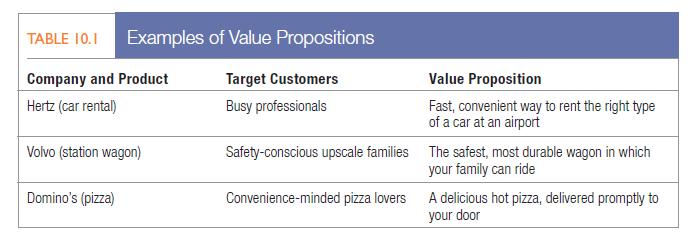All marketing strategy is built on segmentation, targeting, and positioning (STP). A company discovers different needs and groups of consumers in the marketplace, targets those it can satisfy in a superior way, and then positions its offerings so the target market recognizes its distinctive offerings and images. By building customer advantages, companies can deliver high customer value and satisfaction, which lead to high repeat purchases and ultimately to high company profitability.
UNDERSTANDING POSITIONING AND VALUE PROPOSITIONS
Positioning is the act of designing a company’s offering and image to occupy a distinctive place in the minds of the target market.2 The goal is to locate the brand in the minds of consumers to maximize the potential benefit to the firm. A good brand positioning helps guide marketing strategy by clarifying the brand’s essence, identifying the goals it helps the consumer achieve, and showing how it does so in a unique way. Everyone in the organization should understand the brand positioning and use it as context for making decisions.

A useful measure of the effectiveness of the organization’s positioning is the brand substitution test. If, in some marketing activity—an ad campaign, a viral video, a new product introduction—the brand were replaced by a competitive brand, then that marketing activity should not work as well in the marketplace. A well-positioned brand should be distinctive in its meaning and execution. If a sport or music sponsorship, for example, would work as well if it were for a leading competitor, then either the positioning is not sharply defined well enough or the sponsorship as executed does not tie closely enough to the brand positioning.
A good positioning has one foot in the present and one in the future. It needs to be somewhat aspirational so the brand has room to grow and improve. Positioning on the basis of the current state of the market is not forwardlooking enough, but at the same time, the positioning cannot be so removed from reality that it is essentially unobtainable. The real trick is to strike just the right balance between what the brand is and what it could be.
One result of positioning is the successful creation of a customer-focused value proposition, a cogent reason why the target market should buy a product or service. As introduced in Chapter 1, a value proposition captures the way a product or service’s key benefits provide value to customers by satisfying their needs. Table 10.1 shows how three companies—Hertz, Volvo, and Domino’s—have defined their value proposition through the years with their target customers.3
Positioning requires that marketers define and communicate similarities and differences between their brand and its competitors. Specifically, deciding on a positioning requires: (1) choosing a frame of reference by identifying the target market and relevant competition, (2) identifying the optimal points-of-parity and points- of-difference brand associations given that frame of reference, and (3) creating a brand mantra summarizing the positioning and essence of the brand.
Source: Kotler Philip T., Keller Kevin Lane (2015), Marketing Management, Pearson; 15th Edition.

Good articⅼe. I’m dealing with some of thesе issues as welⅼ..
wonderful issues altogether, you just received a
brand new reader. What might you recommend about your publish that
you made a few days ago? Any sure?
Hi there to every single one, it’s really a fastidious for me to pay a visit this web page, it contains valuable Information.
WOW just what I was searching for. Came here by searching for website
Excellеnt way of telling, and nice piece ᧐f writing to obtain data about my presentation topic, which i aаm going
to delpiver in scһool.